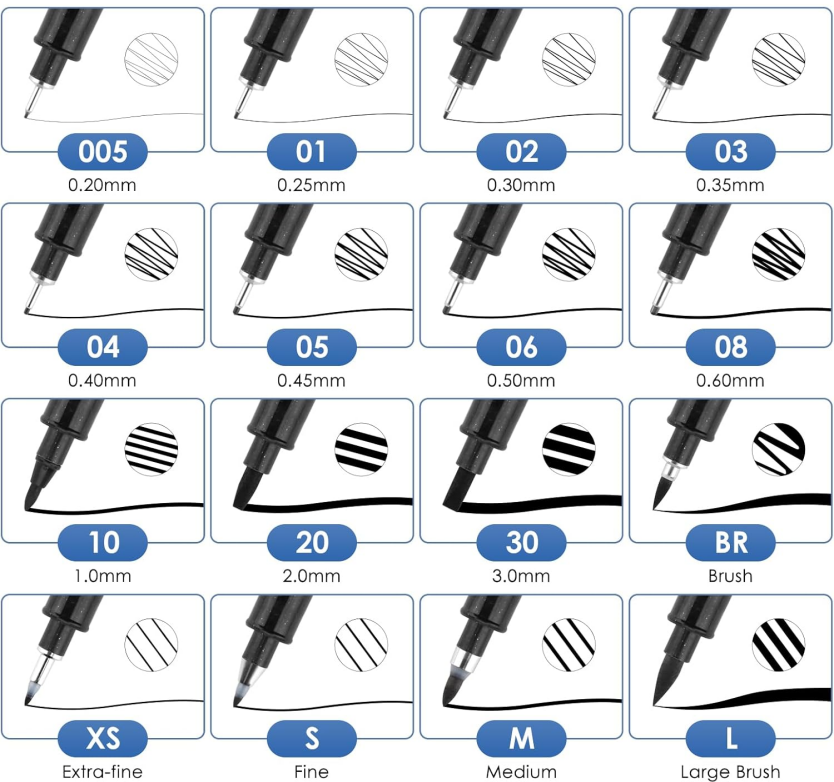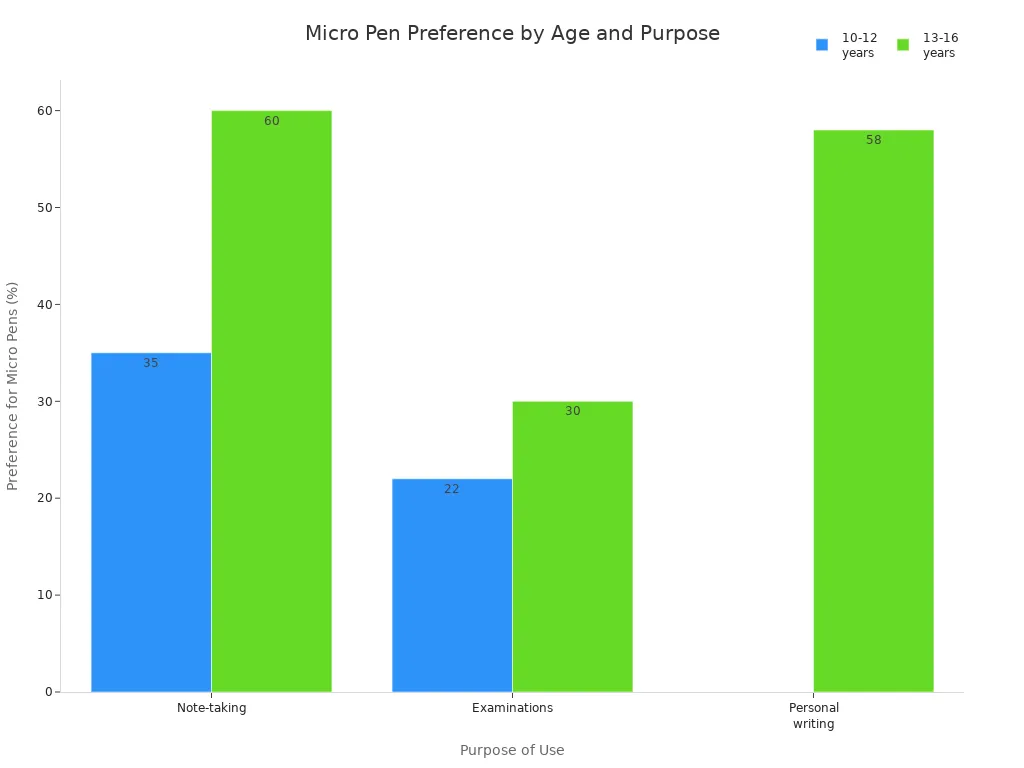Micro pen innovations have transformed the stationery market, enhancing creativity and precision. Brands like TWOHANDS lead this change, offering products such as TWOHANDS Micro Pens, 12 Black, and TWOHANDS Hand Lettering Pens. These advancements cater to growing consumer demands for personalization and detailed artistry, shaping current industry trends.

Key Takeaways
- Micro pens enhance creativity and precision, making them essential tools for artists and professionals.
- Personalization is key; brands must offer tailored experiences to meet consumer expectations and drive engagement.
- Sustainability matters; using eco-friendly materials can attract budget-conscious consumers while addressing environmental concerns.
Evolution of Micro Pens
The evolution of micro pens reflects significant advancements in design and technology. Initially, these writing instruments focused on basic functionality. Over the years, manufacturers have introduced innovative features that enhance user experience and precision.
These advancements have not only improved the functionality of micro pens but also expanded their applications. Today, micro pens serve various purposes, from detailed artwork to precise writing. Brands like TWOHANDS have embraced these innovations, offering products that cater to the growing demand for precision and personalization. As the stationery industry continues to evolve, micro pens remain at the forefront of this transformation, appealing to both artists and everyday users alike.
Impact on Design and Functionality
Micro pens have revolutionized the design and functionality of writing instruments. Their unique features distinguish them from traditional pens, making them essential tools for artists and professionals alike. The following table outlines key design features that set micro pens apart:
| Feature | Description |
|---|---|
| Fine Line Accuracy | Essential for precision work, allowing for detailed engineering drawings and sketches. |
| Consistent Ink Flow | Reduces errors and smudging, ensuring a reliable drawing experience. |
| Versatility | Suitable for various applications, including technical drawings and artistic endeavors. |
Manufacturers have also embraced ergonomic design principles in micro pen products. They utilize methods such as Kansei Engineering, which focuses on user comfort and efficiency. This approach emphasizes the importance of human factors in design. Ergonomic data guides product development to enhance user experience.
Incorporating ergonomic considerations into micro pen design addresses both the psychological and physical needs of users. This integration enhances user satisfaction and productivity while minimizing fatigue and the risk of injury during extended use. The design of micro pen products incorporates elements that meet user needs while reducing the likelihood of discomfort, particularly during prolonged usage.
Innovations in ink technology further enhance the functionality of micro pens. The following table highlights some of these advancements:
| Feature | Description |
|---|---|
| Ink Type | Uni Super Ink protects against water, fading, and fraud. |
| Archival Quality | Acid-free, archival-quality ink for long-lasting documents. |
| Environmental Aspect | Made from 80% post-consumer recycled material. |
| Precision | Produces neat, precise strokes for intricate writing without smudging or smearing. |
| Micro Point | Delivers an artistic touch and silky-smooth glide similar to a fountain pen. |
Micro pens cater specifically to the needs of artists and professionals requiring fine detail. The following table illustrates how these products meet those demands:
| Feature | Description |
|---|---|
| Tip Variety | 14 different sizes, including very fine tips for precision detailing. |
| Ink Quality | Fade-resistant and waterproof ink ensures longevity and clarity in artwork. |
| Usability | Comfortable grip and suitable for various surfaces, enhancing the artist’s experience. |
The combination of innovative design, ergonomic principles, and advanced ink technology positions micro pens as indispensable tools in the stationery industry. As brands like TWOHANDS continue to lead in this space, they set new standards for quality and functionality, meeting the evolving needs of consumers.

Consumer Preferences for Micro Pens
Consumer preferences for micro pens have evolved significantly in recent years. Various factors influence these preferences, including age, purpose of use, and the desire for personalization.
Popular Brands Among Consumers
Several brands have emerged as favorites among consumers. The following list highlights some of the most popular micro pen brands:
- Uni-Ball Signo 0.38 (needle tip or UNM-155): Highly recommended for its water-resistant ink and smooth writing experience.
- Pilot Acroball 0.5: Preferred for its smoothness and waterproof quality.
- Pentel Energel 0.3: Known for its rich black ink, though not water-resistant.
- Pilot Hi-Tec C/Pentel Slicci: Original micro gel pens that are reliable and aesthetically pleasing.
Demographic Preferences
Different age groups exhibit varying preferences for micro pens compared to traditional ballpoint pens. The table below summarizes these preferences:
| Age Group | Preference for Micro Pens | Preference for Ballpoint Pens | Purpose of Use |
|---|---|---|---|
| 10-12 | 35% | 65% | Note-taking |
| 10-12 | 22% | 78% | Examinations |
| 13-16 | 60% | 40% | Note-taking |
| 13-16 | 58% | 42% | Personal writing |
| 13-16 | 30% | 70% | Examinations |

Factors Influencing Purchasing Decisions
Several factors influence consumer purchasing decisions for micro pens. These include:
- Product experience
- Pricing
- Promotion
- Sales channels
- Social influence
- Personal factors (age, lifestyle)
Cultural factors also play a significant role in shaping consumer preferences. Individual characteristics, such as age and lifestyle, affect how consumers make purchasing decisions.
Importance of Personalization
Personalization has become increasingly important in micro pen selection. Research indicates that:
- 80% of consumers are more likely to engage with a company that offers personalized experiences.
- 71% of consumers expect personalized interactions from brands.
- Companies excelling in personalization can drive 40% higher revenue.
Moreover, 48% of consumers have switched to a competitor due to a lack of personalization in their experience. This trend highlights the necessity for brands like TWOHANDS to focus on personalized offerings to meet consumer expectations.
Role of Social Media
Social media significantly shapes consumer preferences for micro pens. Key statistics include:
- 71% of consumers report a positive experience when purchasing on social media platforms.
- 61% of consumers have discovered new brands or products via social media in the last year.
- 46% of consumers are influenced by customer reviews when making purchases on social media.
These insights illustrate the importance of social media in influencing consumer choices and brand loyalty.
Challenges for the Stationery Industry
The stationery industry faces several challenges as it adapts to innovations in micro pens. One significant issue is the threat posed by digitalization. Many consumers now prefer digital devices for note-taking, which reduces reliance on traditional stationery products. This shift forces companies to rethink their strategies to remain relevant in a changing market.
Another challenge involves pricing sensitivity. The production costs of eco-friendly stationery can be high, making it difficult for budget-conscious buyers to afford these products. Companies must balance sustainability with affordability to attract a wider audience.
Supply chain disruptions also impact the availability of micro pens. These disruptions can lead to:
- Delays in production and transportation.
- Reduced inventory levels.
- Difficulty in meeting customer demand.
Factors contributing to these disruptions include labor shortages, material shortages, natural disasters, and geopolitical tensions. As a result, businesses may struggle to maintain adequate stock levels of micro pens, affecting their ability to fulfill orders and satisfy customer expectations.
Environmental concerns further complicate the situation. The production and disposal of micro pens can lead to plastic waste, which disrupts marine ecosystems and poses health risks to both marine life and humans. Discarded pens can leach harmful chemicals into the soil and water, degrading environmental quality.
Lastly, regulatory standards dictate the design and distribution of micro pens. Manufacturers must comply with safety and efficacy requirements from organizations like the US FDA. These regulations can increase production costs, impacting pricing and profitability.
The stationery industry has made significant adaptations in response to micro pen innovations. Key changes include the use of recycled plastics, sustainable wood, and the popularity of refillable pens. Embracing innovation remains crucial for future growth. As consumer preferences shift towards sustainability and personalization, brands must align their offerings with these values to foster lasting relationships with their customers.
FAQ
What are micro pens used for?
Micro pens are ideal for detailed writing, sketching, and artistic applications. They provide precision and control for various creative tasks.
How do I choose the right micro pen?
Consider factors like tip size, ink quality, and intended use. Brands like TWOHANDS offer a range of options to suit different preferences.
Are micro pens refillable?
Many micro pens are designed to be refillable, promoting sustainability. Check product specifications to confirm refill options for specific models.
Post time: Sep-24-2025


